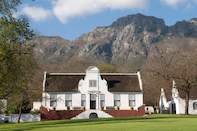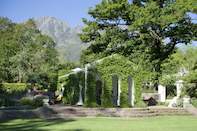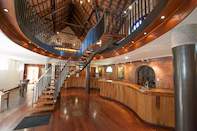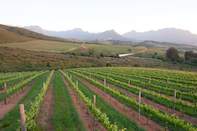Simonsberg

One of the Cape’s most venerable farms continues to make world-famous wines, while sensitive restoration of its historic homesteads and beautiful gardens continues under the loving custodianship of the Barlow family.
An Architectural Treasure

The Barlows of Rustenberg are descended from an old Lancashire family dating back to the rule of Richard II. So it is perhaps not surprising that William Shakespeare’s King Richard II may drift into your thoughts as you approach the winery through a gentle landscape of green trees and pastures dotted with soft-eyed Jersey cows: ‘This happy breed of men, this little world... this blessed plot, this earth, this realm, this England.’
But then the imposing Simonsberg rearing up behind a vintage Cape Dutch farmhouse brings you back to the Stellenbosch winelands with a bump. Rustenberg’s history, dating back to the late 17th century, is steeped in not only English tradition, but also the Cape Dutch influences on wine farming and architecture in South Africa.
The limited-edition book on Rustenberg, regularly updated and usually available in the tasting room, will tell you more, and there is no better way to spend a winter’s day than beside the log fire with a glass of something at your elbow and the book on your knee.
Incumbent owner Simon Barlow took over the reins at Rustenberg in 1987 from his late mother Pam, who had been managing vineyards, cellar, orchards and dairy since the death of her husband Peter in 1975.
They had re-united Rustenberg (the private family home) and Schoongezicht (the hub of farming activity, including the wine cellar and tasting room) in the 1960s, restoring both historic homesteads.
According to South African architectural historians Hans Fransen and Mary Cook, Schoongezicht ‘has few equals in the Cape and its front façade is in perfect order’.
Hi-tech Meets Natural Beauty

Simon, trained in agriculture and a progressive thinker (he’s a former governor of the Agriculture, Food and Industry Section of the World Economic Forum which meets in Davos, Switzerland, each year), is committed to farm community upliftment and environmental conservation projects.
Farmworkers run a trout-breeding scheme on farm dams. As a BWI (Biodiversity & Wine Initiative) member, Rustenberg focuses on eradicating alien vegetation and protecting wetland, costly exercises for a 1200-hectare private spread.
Swathes of restored mountain fynbos vegetation are home to caracal, porcupine, small wild antelope and the re-emerging Cape leopard. This, together with Simon’s wife Rozanne’s sprawling English gardens (including a Chartres-style labyrinth), provides pollen for foul-brood-free beehives, contributing both to farm honey harvests and valuable national bee research efforts.
Most importantly, Rustenberg’s self-described ‘custodian’ has overseen the evolution of this wine farm from venerable Cape First Growth to a 21st-century South Africa benchmark on the international stage.
Rustenberg Vineyards

In the vineyards, Simon has developed new clones, planted experimental varieties as components to enrich award-winning blends, installed futuristic water management measuring systems, and set up a private nursery for virus-free plant material.
In the 1990s, a multi-million overhaul of the Schoongezicht homestead included cleverly incorporated hi-tech tank, barrel and bottling facilities in historic farm buildings.
In these peaceful surroundings, it’s not easy to imagine beneath your feet a tunnel along which wine, barrels and winemaker Craig Christians (son of 30-year winery and vineyard veteran Randolph) and his workers move between the semi-subterranean fermentation cellar, the underground barrel maturation room and the bottling line in the original 18th-century cellar.
This is also the preserve since 2012 of Simon’s cellarmaster son Murray, with a Masters in Oenology from Australia’s Adelaide University and twice winner (in 2013 and 2015) of the prestigious Diners Club Young Winemaker of the Year award, for his Chardonnay and one of his ‘special-project’ red blends respectively.
Reds are Rustenberg’s forte, and they include the Peter Barlow, a rare Cabernet Sauvignon from a single vineyard of 20-year-old vines and the John X Merriman, one of the Cape’s finest Bordeaux-style blends whose name recalls a former owner of Schoongezicht and prime minister of the Cape in the early 20th century.
Among the whites, three Chardonnays demonstrate the versatility and quality potential of this grape. The rich Five Soldiers comes from a single vineyard where five tall pine trees stand guard, while the flagship Stellenbosch Chardonnay emphasises regionality and the third wine is a fine unoaked illustration.
 Stellenbosch is arguably the wine capital of South Africa. Winemaking dates back to its settlement in the 17th century and remains the lifeb...
Stellenbosch is arguably the wine capital of South Africa. Winemaking dates back to its settlement in the 17th century and remains the lifeb...